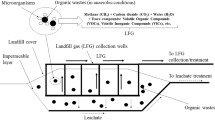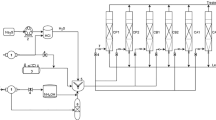Abstract
Approximately 15000 L of unleaded gasoline werereleased into the surrounding vadose zone from aleaking underground storage tank. Initialremediation was by soil vapor extraction andcombustion which soon became cost prohibitive, asadded propane was required to reach the combustionlimit of the extracted vapors. As a cost effectivealternative, a field-scale compost based biofilterwas used in conjunction with soil vapor extractionto remediate the vadose zone. The biofilter wasconstructed on site using 4:1 diatomaceousearth:composted horse manure. Results of a fivemonth study showed that the biofilter removedapproximately 90% of total petroleum hydrocarbons(TPH) and >90% of the BTEX compounds (benzene,toluene, ethylbenzene, xylene), achieving thestringent permit requirements set at either 90% TPHreduction or less than 1.36 kg per day of volatileorganic compounds (VOC's) released to theatmosphere. The biofilter showed the capacity toreadily adapt to changing environmental conditionssuch as increased contaminant loading, andvariations in temperature and moisture. Thebacterial population in the biofilter was uniformlydiverse throughout the biofilter, suggesting that aconsortium of bacteria was needed for efficientbiodegradation. The cost of biofilter set up andoperation saved 90% in the first year alone of theoperating expenses incurred by soil vapor extractionand combustion.
Similar content being viewed by others
References
Artiola JF (1990) Determination of carbon, nitrogen, and sulfur in soils, sediments, and wastes: A comparative study. Intern. J. Environ. Anal. Chem. 41: 159–171
Atlas RM (1994) Microbial hydrocarbon degradation-bioremediation of oil spills. J Chem. Tech. Biotech. 52: 149–156
Atlas RM (1995) Bioremediation. Chem. & Engin. News 73: 32–42
Bohn H (1992) Consider biofiltration for decontaminating gases. Chem. Engin. Prog. 25: 34–40
Brendecke JW, Axelson RD & Pepper IL (1993) Soilmicrobial activity as an indicator of soil fertility: long-term effects of municipal sewage sludge on an arid soil. Soil Biol. Biochem. 25: 751–758
Danielson RE & Sutherland PL (1995) In: Klute A (Ed) Methods of Soil Analysis Part 1: Physical and Mineralogical. SSSA Inc., Madison, WI
Dowd RM (1994) Leaking underground storage tanks. Environ. Sci. Technol. 18: 10
Hodge DS & Devinny JS (1994) Biofilter treatment of ethanol vapors. Environ Prog 13: 167–173
Leson G & Winer AM (1991) Biofiltration: An innovative air pollution control technology forVOC emissions. Air & Waste Manage. Assc. 41: 1045–1054
Martin FJ & Loehr RC (1996) Effect of non-use on biofilter performance. J. Air & Waste Manage. Assc. 46: 539–546
Miller ME, Pederson TA, Kaslick CA & Hoag G (1992) Soil vapor extraction column experiments on gasoline contaminated soil. USEPA/600/sr-92/170 Oct 92
Ottengraf SPP (1986) In: Rehm HJ & Reed G (Eds.) Biotechnology Vol. 8; VCH Verlagsgesellschaft, Weinheim
Page AL, Miller RH & Keeny DR. (1982) In: (Ed) Methods of Soil Analysis, Part 2, Chemical and microbiological, 2nd ed. Agonomy 9, ASA, SSSA Inc., Madison, WI
Shimp JF, Tracy JC, Davis LC, Lee E, Huang W, Erickson LE & Schnoor JL (1993) Beneficial effect of plants in the remediation of soil and groundwater contaminated with organic materials. Critical Rev. in Environ. Sci. and Tech. 23: 41–77
Tang H-M, Hwang S-J & Hwang S-C (1995) Dynamics of Toluene Degradation in Biofilters. Hazardous Waste & Hazardous Materials. 12: 207–219
Togna PA & Singh M (1994) Biological vapor-phase treatment using biofilter and biotrickling filter reactors: Practical operating regimes. Environ. Prog. 13: 94–97
Zhou E & Crawford RL (1995) Effects of oxygen, nitrogen, and temperature on gasoline biodegradation in soil. Biodegrad. 6: 127–140
Zilli M, Converti A, Lodi A, Del Borghi M & Ferraiolo G (1993) Phenol removal from waste gases with a biological filter by Pseudomonas putida.Biotechnol. Bioeng. 41: 693–699
Zilli M, Fabiano B, Ferraiolo A. & Converti A (1996) Macro-kinetic investigation on phenol uptake from air by biofiltration: Influence of superficial gas flow rate and inlet pollutant concentration. Biotechnol. Bioeng. 49: 391–398
Author information
Authors and Affiliations
Rights and permissions
About this article
Cite this article
Jutras, E.M., Smart, C.M., Rupert, R. et al. Field-scale biofiltration of gasoline vapors extracted from beneath a leaking underground storage tank. Biodegradation 8, 31–42 (1997). https://doi.org/10.1023/A:1008233614270
Issue Date:
DOI: https://doi.org/10.1023/A:1008233614270




